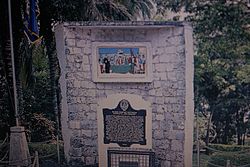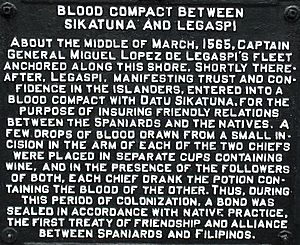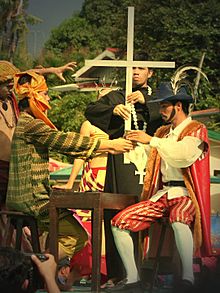Sandugo facts for kids
The Legazpi-Sikatuna Blood Compact (also called Sandugo) was a special agreement. It happened on March 16, 1565, on the island of Bohol in the Philippines. The agreement was between the Spanish explorer Miguel López de Legazpi and Datu Sikatuna, a local leader from Bohol. They performed a "blood compact" to show their friendship. This was a tribal tradition. Many people see this as the first friendship treaty between Spaniards and Filipinos. The word "Sandugo" comes from the Visayan language. It means "one blood."
The Sandugo event is so important that it's shown on Bohol's provincial flag. It's also on the official seal of the Bohol government. The seal even tells the story of the event. It shows where the Spanish ships landed and where the treaty was made on March 16, 1565.
A New Friendship Begins
In 1521, the explorer Ferdinand Magellan arrived in the Philippines. He was on a Spanish trip to the Moluccas, also known as the Spice Islands. Magellan was the first person from Europe to reach Asia by sailing west. Sadly, he died in the Philippines during this journey.
Spain kept sending trips to explore and settle the East Indies. They wanted to control the spice trade, competing with Portugal. But these early trips did not succeed.
It wasn't until 1565 that Miguel López de Legazpi reached the Philippines. He sailed from Mexico with five ships and 500 men. He then set up the first Spanish settlement.
When López de Legazpi arrived, some local tribes were not friendly. They did not want foreign invaders. He tried to land on the island of Cebu, but one of his soldiers died. So, he decided to explore other islands and try to trade with different tribes.
Legazpi's ships sailed south towards Mindanao. Strong winds forced them to turn north to the island of Bohol. There, they captured a ship from Borneo. The sailors on that ship were Malay. They told the Spaniards that the people in Bohol traded with people from Borneo and Indonesia.
When Legazpi arrived in Bohol, he noticed the people were not friendly. The Malay servant explained why. Portuguese explorers from the Moluccas islands had visited in 1563. They had captured about 1,000 people from the Visayan islands and made them slaves.
López de Legazpi, with help from the Malay sailor, explained to the Bohol tribes that they were not Portuguese. He told them they had come to trade peacefully. After hearing this, the local leaders and their tribes became much friendlier. They welcomed the Spaniards.
The Sandugo Ceremony
The Sandugo ceremony happened after Miguel López de Legazpi arrived in Bohol in 1565. It was a way for Datu Sikatuna to show his loyalty to the King of Spain.
To perform the ritual, both men made a small cut on their left arm. They used a dagger for this. Then, they let their blood drip into a cup filled with wine. They both drank the mixture. This was done to honor their new friendship.
The compact was an important part of the local tribal traditions. It showed a strong promise between two groups.
Why the Sandugo Was Important
Performing a blood compact helped keep a strong bond of friendship between two tribes. This ceremony was the first official agreement or friendship treaty between the native Filipinos and the Spaniards.
To honor this important event, a former President of the Philippines, Elpidio Quirino, created the Order of Sikatuna. This is a special award given to politicians.
Juan Luna, a famous Filipino painter, showed this event in his painting. It is called The Blood Compact (or El Pacto de Sangre in Spanish). He painted it in 1883. This painting won first prize in Paris in 1885. It also won an award at the Louisiana Purchase Exposition in St. Louis in 1904.
In those times, performing the sandugo was a very important part of making peace between different groups. A monument was built in Tagbilaran City to remember this event. It was put up by the Philippine Historical Committee and the National Historical Institute.
See also
 In Spanish: Sandugo para niños
In Spanish: Sandugo para niños




